About Desert Rose: Unraveling the Beauty of Adenium Obesum
Known for their brilliant flowers and sculptural stems, Desert Roses (Adenium obesum) are a testament to the beauty that can flourish in arid environments. Native to the arid regions of Africa and the Middle East, these plants have adapted to thrive in challenging conditions, making them both a resilient and stunning addition to your garden or indoor plant collection.
Noted for its stunning floral display and distinctive, succulent stems and roots, the Desert Rose has become a beloved plant among gardeners and plant enthusiasts worldwide.
Desert Rose’s allure is undoubtedly in its magnificent blooms, characterized by their vibrant hues of red, pink, white, and variations in between. The flowers are contrasted beautifully by thick, dark green leaves. The base of the plant is caudex-like, swollen and woody, storing water to help the plant survive through drought conditions.
In this article, we delve into the enchanting world of the Desert Rose, exploring its origins, characteristics, and the mystique that surrounds this resilient flora.
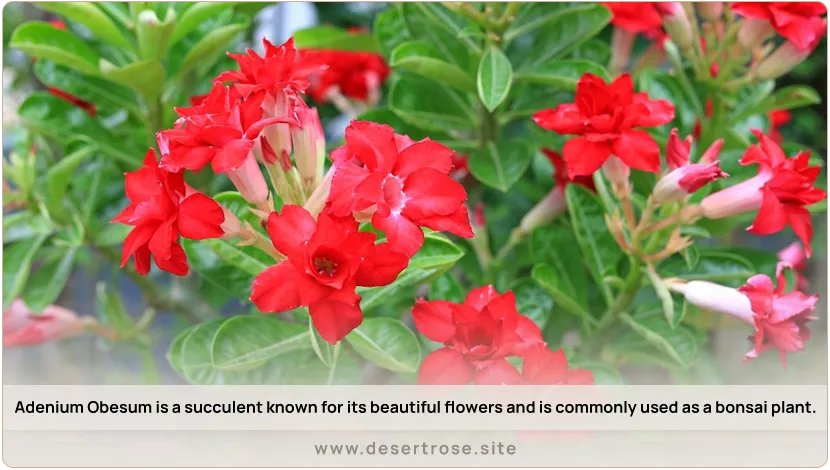
Desert Rose Plant Overview
| Characteristic | Description |
|---|---|
| Plant Type | Succulent |
| Family | Apocynaceae |
| Genus | Adenium |
| Species | Obesum |
| Plant Spacing | 10 ft + |
| Native Area | Africa, Middle East, Madagascar |
| Sunlight Exposure | Full Sun |
| Plant Height | 3-15 ft |
| Water Requirements | Medium |
| Plant Depth | Soil Level |
| Hardiness Zone | 11-12 |
| Maintenance | Low |
| Soil Type | Sandy, well-draining |
| Pest | Mealybugs, aphids, spider mites |
| Diseases | Fungal Disease |
How To Grow Desert Rose
Caring for Adenium Obesum is fairly straightforward, making it an excellent choice for those new to the world of bonsai. Similar to other succulents, this plant thrives with the right balance of sunlight and water.
In the following section, we’ll explore these care essentials in detail. Let’s get started.
Selecting Your Plant
Seeds
Starting a Desert Rose from seeds can be an exciting venture. The seeds, often easily available online or at specialized nurseries, hold the promise of genetic diversity, resulting in a plethora of flower colors and forms. Every seed-grown Desert Rose is a unique individual, showcasing a captivating blend of characteristics inherited from its parent plants.

Procedure
- Seed Selection: Choose viable, healthy seeds. Look for plump, firm seeds with no signs of damage or disease.
- Germination Process: Plant the seeds in a well-drained soil mix, barely covering them with soil. Keep the soil slightly moist but not wet, and provide ample light. Germination should typically occur within a week or two.
- Transplanting: Once the seedlings have developed a couple of true leaves, they can be gently transplanted to larger containers or directly outdoors, depending on the climate.
Cuttings
Starting from cuttings is another viable option, especially if you wish to replicate the exact characteristics of a particular parent plant. The cuttings should be taken from healthy, disease-free plants.
Procedure
- Cutting Selection: Choose a healthy branch, ideally a young, vigorous shoot. Use a sharp knife or pruning shears to make a clean cut.
- Curing: Allow the cutting to dry for a few days to form a callus at the cut end. This process helps to prevent rot when the cutting is planted.
- Planting: Insert the cured cutting into a pot with well-drained soil, burying it just enough to keep it upright. Water lightly and provide bright, indirect light until roots develop.
- Root Development: Once the cutting has rooted, which typically takes a few weeks, it can be treated as a mature plant, gradually introducing it to direct sunlight.
Planting Procedure
Soil Preparation
The Desert Rose is not overly picky about soil but prefers a well-draining mix that mimics its natural sandy habitat. Incorporating perlite, sand, or gravel can enhance drainage, providing the ideal environment for your plant.
Planting Steps
- Soil Mixture: Prepare a soil mix consisting of two parts sand or perlite, one part potting soil, ensuring it’s well-aerated and drains excess water quickly.
- Container Selection: If planting in a container, ensure it has ample drainage holes to prevent waterlogging. The size of the container should provide enough room for the roots to grow but not be overly spacious.
- Planting Depth: Place the Desert Rose so that the top of the root ball is just at the soil level. For cuttings, plant them at a depth enough to hold them upright.
- Watering: Water the plant sparingly after planting, allowing the soil to dry out before the next watering.
- Sunlight: Place the plant in a location where it will receive at least 6-8 hours of direct sunlight. Adjust the light exposure based on the plant’s response.
By meticulously selecting your Desert Rose, whether from seeds or cuttings, and following a thorough planting procedure, you lay a strong foundation for a healthy, vibrant plant. Every step is crucial, imbuing your plant with the resilience and vigor characteristic of this beautiful species.
Sunlight and Watering
In this crucial phase of caring for your Desert Rose, understanding the plant’s specific needs for sunlight and water is key to promoting its optimal growth and bloom. Here we provide in-depth details on these essential elements.
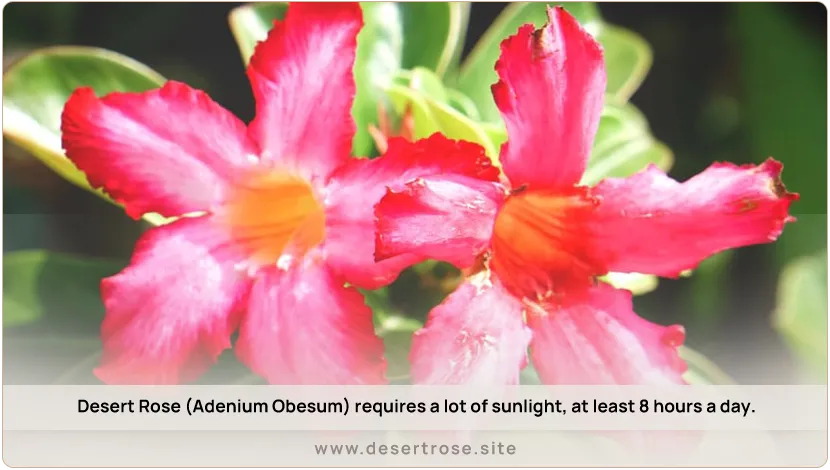
Light Requirements
Desert Roses are lovers of bright light. Native to the arid regions of Africa and the Middle East, these plants have adapted to thrive under the intense sun.
Details
- Duration: At least six hours of direct sunlight is crucial for your Desert Rose to flourish. It ensures the plant develops a robust structure, vibrant foliage, and prolific blooms.
- Intensity: The plant is tolerant of intense light but benefits from some protection during the hottest parts of the day to prevent leaf scorch and overheating.
- Indoor Cultivation: If you’re growing your Desert Rose indoors, place it near a south or west-facing window. Consider using artificial grow lights during darker months to supplement natural light.
- Transition: When moving the plant outdoors for warmer seasons, acclimate it gradually to avoid shock from sudden light exposure.
Watering Routine
The succulent nature of Desert Roses makes them somewhat drought tolerant. However, a balanced watering routine is vital to avoid both dehydration and waterlogging.
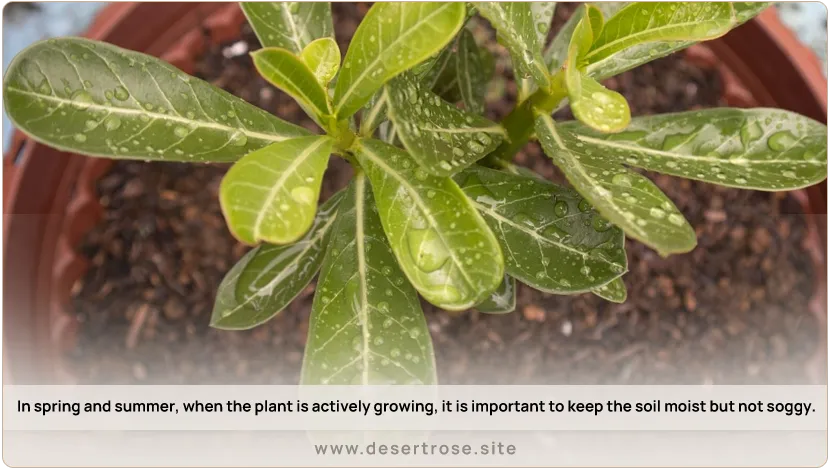
Details
- Frequency: Water the plant sparingly. The ‘soak and dry’ method, where the soil is allowed to dry out completely between watering, is highly effective. It mimics the plant’s natural environment, promoting root health and overall vitality.
- Indicators: Pay attention to the leaves; they can be excellent indicators of the plant’s water needs. Wrinkled or shriveled leaves often indicate the need for water.
- Seasonal Adjustments: Reduce the frequency of watering during the winter months when the plant enters a dormant phase. During this period, the water requirement is minimal, focusing on maintaining just enough moisture to keep the roots alive and healthy.
- Water Quality: Use water that is free of chemicals and salts to prevent the buildup of harmful substances in the soil, which can affect the plant’s health.
Regularly monitor your Desert Rose’s response to the light and water provided. Every plant is an individual and may have slightly different requirements. Make adjustments as needed to ensure that the plant is receiving adequate light and water to support its growth, health, and flowering. Observing the plant’s physical condition, such as leaf color, stem strength, and flower production, can offer valuable insights into its overall well-being.
Feeding and Maintenance
Nurturing a Desert Rose to its full glory involves more than just the basics of sunlight and water. In this step, we delve deeper into the pivotal roles of fertilizing and pruning in the health and aesthetic appeal of your Desert Rose.
Fertilizing
Feeding your Desert Rose with appropriate nutrients is essential to fuel its growth, health, and the production of those iconic vibrant blooms.

Types of Fertilizers
- Balanced Fertilizers: These contain equal amounts of nitrogen, phosphorus, and potassium, providing a well-rounded nutrient boost to support leaf growth, root development, and flowering.
- Slow-Release Fertilizers: These are particularly beneficial as they release nutrients gradually over time, ensuring a consistent supply without the risk of overfeeding.
Application Process
- Frequency: Apply the fertilizer sparingly during the active growing season, typically in the spring and summer. Avoid over-fertilizing as it can lead to nutrient burn or excessive, leggy growth.
- Method: Follow the manufacturer’s instructions regarding the amount and application method. Generally, it involves scattering the fertilizer around the base of the plant and watering it in.
- Monitoring: Observe the plant’s response to fertilization. Adjust the frequency and quantity based on the plant’s growth, color, and overall vitality.
Pruning
Pruning is an art that not only shapes your Desert Rose but also invigorates its growth, enhancing its natural, bonsai-like structure.

Pruning Steps
- When to Prune: The dormant season, typically in late fall or winter, is the ideal time for pruning. The plant’s slowed growth during this period facilitates better healing of the cuts.
- Tools: Use sharp, clean pruning shears or a knife to make precise cuts. Ensure tools are sterilized to prevent the transmission of diseases.
- Technique: Focus on leggy, weak, or diseased branches. Trim them back to maintain a balanced, aesthetic shape, and to encourage a bushier growth.
- Safety Precautions: Be mindful of the plant’s toxic sap when pruning. Wear protective gloves and goggles to prevent skin and eye irritation.
Aftercare
- Healing: Allow the cuts to air dry and heal naturally. Avoid watering immediately after pruning to minimize the risk of infections.
- Shaping: As the plant resumes active growth in spring, you’ll observe a rejuvenated structure, with enhanced branching and improved flower production as a result of prudent pruning.
A judicious approach to feeding and maintenance catapults the Desert Rose from a mere succulent to a spectacle of natural artistry. The combined effects of tailored fertilization and strategic pruning unfold a landscape where each leaf is greener, and every bloom is a vivid testament to the meticulous care infused in every step of this journey.
By immersing in the rhythm of the Desert Rose’s needs, echoing its calls with nutrients and space to breathe, you become more than a gardener. You transform into a custodian of a living art piece, where every bloom is a chapter of a story intricately woven between you and this resilient marvel of nature.
Pest and Disease Management
Maintaining the robust health and aesthetic allure of your Desert Rose encompasses diligent management of pests and diseases. This proactive approach, coupled with prompt remedial measures, is instrumental in preserving the plant’s vigor and splendor.
Pest Management
Pests such as mealybugs, aphids, and spider mites can potentially besiege the Desert Rose, undermining its health and compromising its beauty.
Regular Inspection
- Frequency: Conduct weekly examinations of your plant, paying close attention to the undersides of leaves and stem joints where pests often reside.
- Indicators: Watch out for signs like discolored or damaged leaves, the presence of pests, or unusual sticky residues which are often associated with aphid infestations.
Treatment
- Insecticidal Soap: This is an effective, yet gentle remedy for a range of pests. It works by suffocating the pests without harming the plant or the environment.
- Neem Oil: Renowned for its natural pesticidal properties, neem oil disrupts the life cycle of pests at all stages (egg, larvae, and adult), making it a versatile treatment option.
- Application: Follow the manufacturer’s guidelines for application rates and frequencies to ensure efficacy while safeguarding the plant’s health.
Disease Management
The advent of fungal diseases is often precipitated by excess moisture and inadequate air circulation.
Preventive Measures
- Watering: Implement a prudent watering regimen, allowing the soil to dry out between watering to mitigate the risk of root rot and fungal infections.
- Air Circulation: Ensure that the plant is situated in a location with ample air flow. If indoors, consider the use of fans or periodically opening windows to enhance ventilation.
- Plant Spacing: If you have multiple plants, adequate spacing aids in air circulation and reduces the transmission of diseases.
Identification and Treatment
- Signs: Look out for wilting, discoloration, or unusual spots on leaves as indicators of potential fungal infections.
- Treatment: Application of appropriate fungicides, in accordance with manufacturer’s instructions, can effectively combat fungal diseases. Removing and discarding affected plant parts can also prevent the spread of the infection.
The vigilant eye of the gardener, attuned to the subtlest signs of pests and diseases, is the Desert Rose’s staunchest ally. In the harmonious dance of vigilant observation, preventive practices, and prompt interventions, your Desert Rose not only survives but thrives, unfurling its blooms as emblems of triumph over adversity.
Overwintering: Shielding Desert Rose from the Chill
As temperatures plunge in the colder months, the robust Desert Rose, a native of warmer climes, demands meticulous attention to ensure its survival and prosperity. While the plant stands as a testament to resilience, it is not immune to the perils of frost. Herein, we explore an in-depth guide to overwintering your Desert Rose, ensuring that it not only survives the winter chill but emerges with renewed vigor come spring.
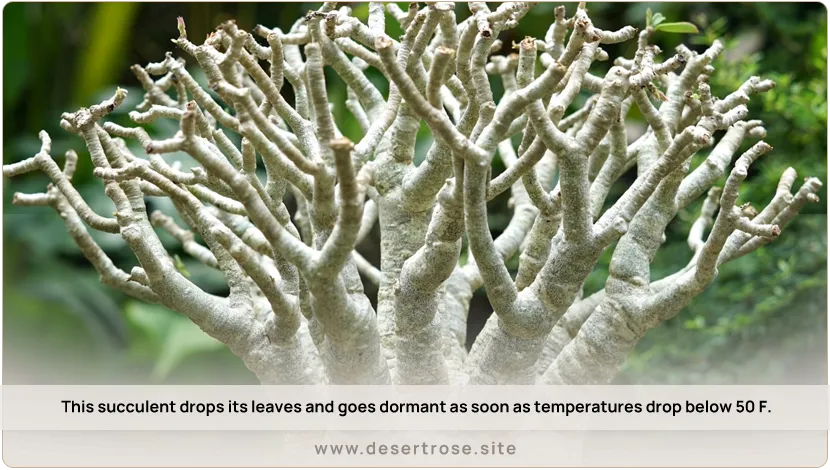
Understanding the Overwintering Challenge
Temperature Sensitivity: Desert Roses are acclimated to warm environments. Temperatures plummeting below 50°F (10°C) can instigate stress and potential damage. Frost, particularly, is a formidable adversary, capable of inflicting irreparable harm.
Physiological Response: Cold stress inhibits the metabolic processes of the Desert Rose, leading to a dormant state. This dormancy is a natural response, but exposure to prolonged cold can be detrimental.
Strategic Overwintering
Indoor Transition: The sanctuary of the indoors provides a haven where the Desert Rose can endure the winter months with minimal stress.
Procedure
- Preparation: Before the onset of cold weather, begin acclimating the plant to reduced light and cooler conditions to minimize shock during the indoor transition.
- Indoor Environment: Choose a location that is cool yet well-lit. While the plant is dormant and requires less light, some light exposure is still essential to its survival.
- Watering Regimen: During overwintering, the water requirement of the Desert Rose diminishes significantly. Water sparingly, ensuring the soil remains relatively dry to prevent root rot.
- Temperature Monitoring: Maintain indoor temperatures above the critical 50°F (10°C) threshold, ensuring the plant remains safe from the peril of frost.
Health Monitoring: Regularly inspect the plant for signs of stress or disease. The indoor environment should be conducive to its dormancy but not detrimental to its health.
Spring Transition: As temperatures rebound with the advent of spring, a gradual reintroduction to the outdoors prepares the Desert Rose for the active growing season ahead.
- Acclimatization: Gradually expose the plant to increased light and temperatures to acclimate it to outdoor conditions, preventing shock.
- Outdoor Transition: Monitor weather forecasts to choose the optimal time for moving the plant outdoors, ensuring frost threats have fully dissipated.
Overwintering is an integral facet of Desert Rose care in regions subjected to cold winters. The meticulous orchestration of its indoor transition, dormancy management, and reacclimation to the outdoors is a testament to the gardener’s prowess.
Each step, executed with precision, ensures that as winter’s icy grip recedes, the Desert Rose emerges, not just a survivor, but a flourishing testament to the triumph of meticulous care over the winter chill.
Repotting: A Detailed Guide to Giving Your Desert Rose a New Home
The process of repotting is akin to providing your Desert Rose with a refreshed living environment, essential for its continuous growth and vitality. As the Desert Rose flourishes, it will eventually require a larger space to accommodate its expanding root system and to replenish the nutrient content of its soil. Below, we unravel the intricate details of the repotting process.
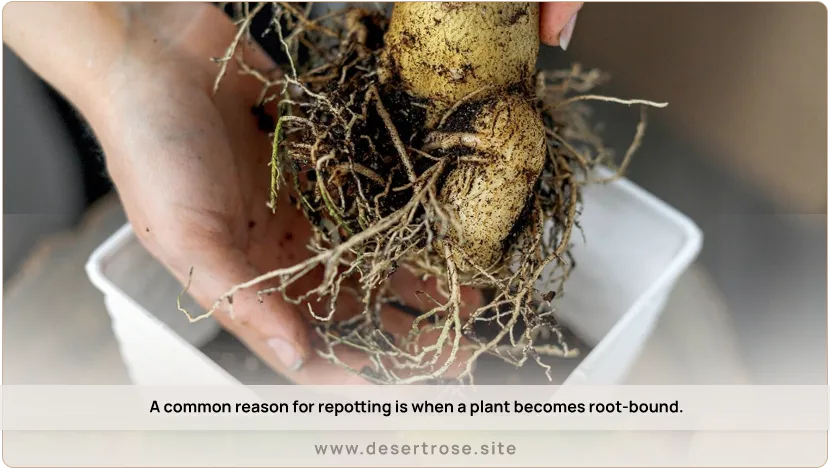
The Need for Repotting
Desert Roses, with their robust growth, often outstrip the confines of their initial pots within 2-3 years. Beyond mere space, repotting addresses the depletion of essential nutrients in the soil, offering the plant a revitalized source of nourishment.
Signs for Repotting:
- Root Crowding: Roots peeking out of the drainage holes or circling the surface of the soil are clear indications of a plant outgrowing its container.
- Stunted Growth: If your Desert Rose appears to be stagnating in growth or its vigor is diminishing, it may be a sign that repotting is necessary.
Step by Step Process of Repotting
1. Choosing the Right Time:
- Repot during the growing season when the plant is most resilient and can recover quickly from the transplant shock.
2. Selecting a Suitable Container:
- Choose a pot that is larger than the current one to provide additional room for growth.
- Ensure the selected pot has ample drainage holes to prevent waterlogging and promote aeration.
3. Preparation:
- Water the plant a day before repotting to make the roots more pliable and the plant easier to remove.
4. Removal:
- Gently remove the Desert Rose from its current pot, taking caution to minimize root damage.
5. Root Examination:
- Inspect the roots for any signs of disease or rot, trimming away any unhealthy sections.
6. Soil Replacement:
- Replace the old soil with a fresh, well-draining soil mix tailored for succulents or specifically for Desert Roses to ensure optimal growth.
7. Repotting:
- Place the plant in the new pot, filling around it with soil until the roots are covered and the plant is secure. However, be cautious not to bury the plant too deep.
8. Watering:
- Water lightly to settle the soil, then allow it to dry out before the next watering to help the roots recover.
9. Placement:
- Initially, place the repotted Desert Rose in a shaded location to recover. Gradually reintroduce it to its usual light conditions.
Post-Repotting Care
Monitor the plant closely for the first few weeks after repotting. It may exhibit signs of transplant shock, such as wilting or leaf drop, which is generally normal. Maintain a balanced watering routine and avoid fertilizing until you see new growth, indicating that the plant has recovered and is settling into its new home.
Repotting is not just a routine task but an opportunity to invigorate your Desert Rose, offering it a renewed lease of life. Each repotting phase is a chapter in the unfolding narrative of your plant’s life, marking periods of growth, renewal, and flourishing vitality. With each transition to a new pot, the Desert Rose unveils a fresh wave of blossoming splendor, echoing the continuous cycle of growth and renewal that defines the natural world.
Safety Precautions with Desert Rose: Handling Its Toxic Sap
Understanding the Toxicity
Desert Rose (Adenium obesum) is renowned for its mesmerizing blooms and sculpted structure. However, a lesser-known attribute of this enigmatic plant is the milky, toxic sap it produces. This sap contains potent chemicals known as cardenolides or cardiac glycosides, which are toxic upon ingestion and can cause skin irritation.
Potential Hazards
1. Human Exposure:
- Skin Irritation: The sap can cause mild to severe skin irritation. Individuals with sensitive skin might experience rash, redness, or itching upon contact.
- Ingestion: If accidentally ingested, the sap can cause vomiting, diarrhea, and other digestive issues. In severe cases, it can impact the heart’s rhythm.
2. Pets and Wildlife:
- Toxicity to Animals: Pets, particularly cats and dogs, can experience similar symptoms to humans if they ingest parts of the Desert Rose. It’s also toxic to a variety of wildlife.
3. Environmental Considerations:
- Containment: Avoid letting the sap come into contact with water sources or soil where it could potentially impact other plants or wildlife.
Handling with Care
Given its toxic nature, handling Desert Rose demands caution to mitigate the risk of exposure.
Protective Gear:
- Gloves: Always wear gloves when handling or pruning the plant to prevent the sap from coming into contact with your skin.
- Eye Protection: Wear goggles or glasses to protect your eyes, especially during pruning or repotting when accidental splashes can occur.
First Aid Measures:
- Skin Exposure: In case of skin contact, wash the affected area immediately with soap and plenty of water to mitigate irritation.
- Ingestion: Seek immediate medical attention if the sap or any part of the plant is ingested, and monitor for symptoms of poisoning.
Keeping Away from Vulnerable Groups
Children and Pets:
- Placement: Ensure that the plant is placed in an area inaccessible to children and pets. Educate children about the dangers associated with touching or ingesting the plant.
- Awareness: Raise awareness among family members and visitors about the plant’s toxicity to ensure cautious handling.
The alluring beauty of the Desert Rose sometimes masks the latent toxicity harbored in its sap. Handling this enigmatic bloom requires a blend of admiration and caution. With informed safety protocols, the mesmerizing allure of the Desert Rose can be enjoyed while mitigating the risks associated with its toxic sap.
Every vibrant bloom and lush leaf, while captivating, also serves as a gentle reminder of the dual nature of this plant – a blend of intoxicating beauty and latent potency. In this paradox, the Desert Rose etches its unique narrative in the annals of flora, a tale of beguiling charm intertwined with innate strength and defense.
Desert Rose Common Problems: Unveiling the Underlying Issues
Every gardener familiar with the exotic beauty of the desert rose (Adenium obesum) also understands that, like all plants, it comes with its own set of challenges. While known for its striking flowers and sculptural form, there are common problems that can hamper the vitality and aesthetics of this plant. Among these are spots on leaves, leaf drop, and specks on lower leaves. Below, we delve into these issues, offering insights into identification, prevention, and management.
Spots on Leaves
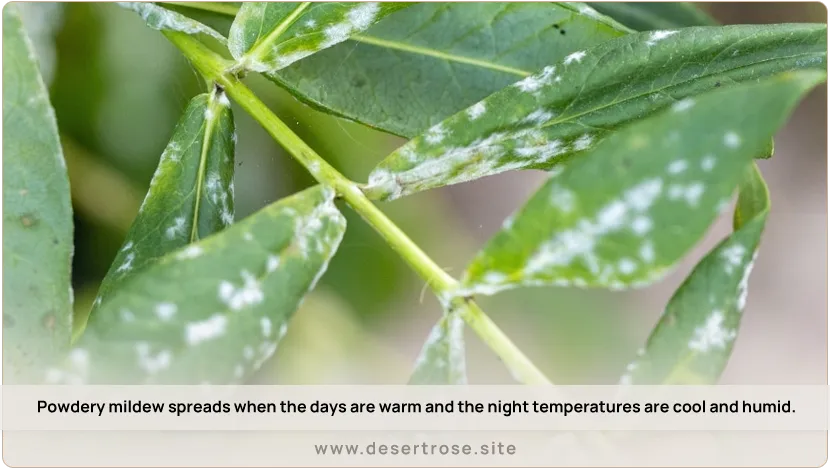
One of the undeniable charms of the desert rose is its lush, green leaves that provide a splendid backdrop for its vibrant blooms. However, spots on leaves can mar this beauty, often signaling underlying health issues. These spots can result from fungal infections like leaf spot disease or rust, often facilitated by excessive moisture and poor air circulation. Ensuring the plant is not waterlogged, providing ample airflow, and avoiding water contact on the leaves are pivotal steps in addressing this problem. For severe cases, appropriate fungicides or organic remedies like neem oil can be employed to restore the leaf’s health and aesthetics.
Leaf Drop
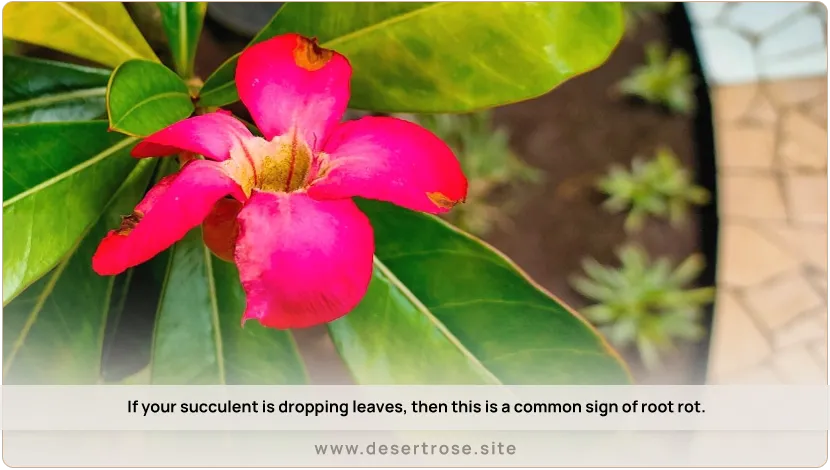
Another issue that can befall desert rose owners is leaf drop, which can be alarming. This phenomenon is often a natural response to changes in weather, especially as the plant enters its dormancy period in cooler months. However, if leaf drop occurs outside this period, it could signal improper watering practices, either too much or too little. The key is to strike a balanced watering routine, allowing the soil to dry out between watering sessions and ensuring the plant receives adequate but not excessive hydration.
Specks on Lower Leaves

Specks on the lower leaves of the desert rose can often be attributed to pest infestation. Aphids, spider mites, and mealybugs are the usual culprits, leaving behind their mark and potentially compromising the plant’s health. Regular inspection and prompt intervention are essential. Insecticidal soaps, neem oil, or removing the pests manually can be effective measures. Enhancing the plant’s overall health through proper watering, adequate light, and nutrition also bolsters its defense against these unwelcome invaders.
While the desert rose is admired for its resilience and minimal care requirements, being vigilant about potential problems ensures that it thrives and continues to grace spaces with its unique beauty. Understanding the causes and remedies for spots on leaves, leaf drop, and specks on lower leaves not only enhances the plant’s health but elevates the enjoyment derived from this exquisite plant. Each challenge offers an opportunity to deepen the connection between the plant and its caregiver, transforming obstacles into pathways for lush, vibrant growth
Author’s Reflection: What I Learned from Desert Rose Plants
In the intricate dance of beauty and care, Desert Roses (Adenium obesum) paint a vivid tableau of vibrant blossoms, sculpted structures, and underlying resilience. However, as is the intrinsic nature of every living entity, these elegant blooms come with their nuanced requirements and inherent challenges. They beckon to the discerning gardener, not just with their visual allure but with the silent appeal for meticulous care, safety, and nurturing.
From the initial phases of selecting the plant, whether from seeds or cuttings, each step of planting, watering, and exposure to sunlight is a delicate blend of science and art. Every droplet of water, beam of sunlight, and granule of nutrient-infused soil transforms into the silent architects of the plant’s lush foliage and mesmerizing blossoms.
Yet, amidst the allure lies the potent presence of toxicity. The sap, as beautiful as the blooms it nourishes, is a reservoir of toxic elements. It echoes the duality of nature – where beauty and potential danger coexist, demanding respect and caution. The safety protocols for handling Desert Roses, the cautious maneuvering around their toxic sap, underline a fundamental principle – that of coexisting with nature in a space of informed respect and understanding.
Overwintering is another essential aspect, a seasonal ritual where the gardener transitions into the role of a protector, shielding the precious blooms from the icy grip of winter. It’s a silent testimony to the cyclical dance of nature, where each season, with its arrivals and departures, imprints upon the Desert Rose a unique signature of growth and resilience.
Repotting emerges as a renewal ritual. It is not just an act of transferring the plant to a new container but a ceremonial offering of space, nutrients, and an environment for unbridled growth. It signifies the Desert Rose’s continuous journey of expansion, an unyielding march towards blossoming grandeur.
In the end, the journey with Desert Roses is emblematic of the gardener’s evolution. Each bloom is a silent narrative of the trials, triumphs, and transformations encountered in the silent, yet expressive, world of these enigmatic blooms. The Desert Rose, in its silent eloquence, narrates tales of resilience, beauty, caution, and care – each petal a chapter, each bloom a story, unfolding in the silent sanctuary of nature, where attentive care meets unyielding vitality.
In this narrative, every gardener, every observer, is invited not just to witness but to participate. To step into a world where beauty and care, blossoms and safety precautions, seasons and protective measures, weave the intricate narrative of life – vibrant, resilient, and perpetually blossoming amidst challenges. The Desert Rose, with its silent yet expressive demeanor, invites a harmonious coexistence, a journey where care, caution, and beauty converge in the timeless dance of nature’s unyielding spectacle.
FAQs (Frequently Asked Questions)
What is Sahara Desert Rose?
The Sahara Desert Rose is a crystalline structure made of gypsum or baryte and sand grains embedded in them. It is naturally found in arid, desert regions, particularly in the Sahara Desert.
What does a Desert Rose look like?
A Desert Rose plant boasts succulent leaves, a thick, swollen stem, and vibrant flowers that can range in color from red to pink to white. The Sahara Desert Rose crystal resembles a blooming rose, characterized by layered petals of delicate, rosette-like gypsum or baryte formations.
How do Desert Roses form?
Desert Rose plants grow from seeds, developing a caudex (swollen base or stem) and succulent leaves. Sahara Desert Roses (the crystals) are formed in arid regions where water evaporates, leaving behind intricate, rosette-shaped crystals.
Where are Desert Roses found?
Desert Rose plants are native to Africa and the Arabian Peninsula. The Sahara Desert Rose crystal can be found in arid desert regions, including the Sahara Desert.
What is the value of Desert Roses?
Desert Rose plants are valued for their aesthetic appeal and resilience. Sahara Desert Rose crystals are sought after for their unique, natural formations and are sometimes used for their metaphysical properties.
How to identify a real Desert Rose?
A real Desert Rose plant has succulent leaves, vibrant flowers, and a thick, bulbous base. For Sahara Desert Rose crystals, authenticity can be verified by their characteristic rosette shape and the environment in which they are found.
What is the difference between a Desert Rose and a gypsum crystal?
A Desert Rose is a specific type of gypsum crystal characterized by its rosette-like shape, formed with layers of gypsum and sand grains. Not all gypsum crystals take this distinct form.
How can I tell if my Desert Rose is real?
Examine the physical characteristics, such as the succulent leaves and flowers for the plant, or the rosette-like structure for the crystal. Also, consider where it was found or purchased and consult with a botanist or geologist if needed.
How often should I water my desert rose?
Desert rose should be watered sparingly. Allow the soil to dry out completely between waterings. Over-watering or letting the plant sit in water can lead to root rot.
How often to water desert rose in summer?
During the summer, increase the watering frequency slightly as the plant will use more water in hot weather. However, ensure the topsoil is dry before adding more water. Always avoid waterlogging.
How to care for desert rose plant?
Care for a desert rose includes providing full sun exposure, using well-draining soil, watering sparingly, and protecting it from frost. Pruning and fertilizing during the growing season also enhance its growth and blooming.
How to get desert rose out of dormancy?
Increase light exposure and gradually reintroduce watering to wake a desert rose from dormancy. Ensure ambient temperatures are warm enough, avoiding frost or cold weather.
How to prune desert rose?
Prune desert rose during its dormant season. Use sharp, clean pruning shears to remove dead or weak branches, promoting a more bushy growth and better air circulation. Always wear protective gear to avoid contact with the toxic sap.
How to trim desert rose roots?
Root trimming should be done during repotting. Remove the plant from its pot, trim off any dead or overly long roots, and replant it in fresh, well-draining soil.
How to care for a desert rose?
Provide adequate sunlight, water sparingly, use well-draining soil, and protect from frost. Regularly inspect for pests and diseases and address them promptly. Fertilize lightly during the growing season.
How to make desert rose bloom?
Ensure it receives plenty of sunlight, and consider using a balanced, slow-release fertilizer during the growing season. Avoid over-watering and ensure optimal temperatures to encourage blooming.
How to force desert rose to bloom?
Increase light exposure, optimize watering, and consider using a phosphorus-rich fertilizer to promote blooming. Maintain optimal temperature and air circulation.
How to take care of desert rose?
Ensure it gets at least 6 hours of sunlight daily, water it sparingly, use well-draining soil, and protect it from frost. Fertilize lightly during growing season and prune as needed.
What type of soil is best for desert rose?
Use a well-draining soil mix, preferably cactus or succulent mix. Incorporating sand or perlite to the mix can enhance drainage and aeration.
What is the best fertilizer for desert rose?
A balanced, slow-release fertilizer with a N-P-K ratio of about 15-15-15 can be beneficial. Fertilize lightly during the growing season.
What Are The Desert Rose Care tips
Provide adequate sunlight, water sparingly and let the soil dry out between waterings, use well-draining soil, protect from frost, and manage pests and diseases promptly.
How do I water my desert rose?
Water it sparingly and ensure the soil is dry before adding more water. Use a watering can to apply water at the base of the plant, avoiding the leaves and flowers.
How do I revive a dying desert rose?
Identify the issue first – be it over-watering, inadequate light, pest infestation, or disease. Correct the problem by adjusting watering, improving light exposure, treating pests, or addressing diseases. Trim dead or diseased parts and consider repotting in fresh, well-draining soil if necessary.
How to Grow Desert Rose from Seed?
Growing a desert rose from seed requires patience and precision. Begin by soaking the seeds in warm water to soften the outer layer, enhancing germination prospects. The seeds are then planted in well-draining soil, a crucial aspect to avoid waterlogging and root rot. A warm and bright environment fosters growth; however, direct sunlight is to be avoided until the seeds sprout. Maintaining a slightly moist soil ensures the young plants receive adequate hydration without being overwhelmed.
How to Grow Desert Rose?
Cultivating a desert rose is a balance of providing optimal sunlight, precise watering, and safeguarding from frost. These plants relish at least six hours of direct sunlight daily. The soil should be allowed to dry out between watering to prevent over-hydration. Although desert roses are somewhat tolerant, protection from extreme cold is essential to avoid frost damage.
How to Plant Desert Rose Seeds?
The process of planting desert rose seeds is both an art and science. After soaking the seeds, they are laid gently atop well-draining soil and covered lightly. The initial stages of growth require a moist environment, but not soaked. Bright, indirect light warms the emerging seedlings, and with patience, the first shoots make their appearance, marking the commencement of a new life cycle.
How to Propagate Desert Rose Succulent?
Propagating a desert rose from cuttings is a common practice. A healthy cutting is obtained and left to dry for several days, allowing the cut section to callous, reducing the risk of rot when planted. The cutting is then inserted into well-draining soil, watered lightly, and placed in a location with bright, indirect light until roots form, signaling successful propagation.
How to Propagate Desert Rose?
Whether through seeds or cuttings, propagation is a meticulous process. Seeds should be well-tended in their initial stages, ensuring they receive adequate light and moisture. For cuttings, the focus shifts to allowing the wound to heal before planting, ensuring a higher success rate of rooting and growth.
How to Germinate Desert Rose Seeds?
Germination is the first step towards a new plant. For desert rose seeds, this involves a warm, moist environment and indirect light. The seeds, once soaked and planted, begin their journey of transformation under these conditions. In a few weeks, with optimal care, sprouts signal the beginning of a new growth phase.
How to Plant Desert Rose?
Planting a desert rose involves selecting a sunny location and using well-draining soil to accommodate its natural habitat needs. The plant’s root base should be above the soil to prevent rot. Watering should be moderate, and regular monitoring for pests and diseases ensures the plant’s health and vitality.
How to Grow Desert Rose from Cutting?
To grow a desert rose from a cutting, a healthy branch is selected and cut, then left to dry for several days to heal the cut surface. The prepared cutting is planted in well-draining soil, given minimal water, and placed in a location with adequate light. The emergence of roots indicates successful propagation.
When are Desert Rose Seed Pods Ready?
Desert rose seed pods signal their readiness when they turn a brownish hue and begin to crack open. This transformation indicates the seeds within are mature, ready for collection, and subsequent planting. The seeds can be stored in a dry place for future use or planted immediately to initiate the propagation process.
How do I Propagate My Desert Rose?
Propagating your desert rose can be accomplished via seeds or cuttings. If using seeds, ensure they are sown in a conducive environment characterized by warm temperatures, moist soil, and indirect light. For cuttings, the focus is on allowing them to dry and callous before planting in well-draining soil and maintaining a warm, bright environment to encourage rooting.
What Are The Desert Rose Diseases
Desert rose plants can be affected by a range of diseases, primarily caused by fungi. The most common issue is root rot, resulting from overwatering or poor drainage in the soil. The signs of this disease are often wilting leaves and a soft, brown base. Additionally, leaf spot or mildew can occur when the foliage is kept too moist or when air circulation is inadequate. Regular inspection and immediate intervention are key to managing and mitigating the effects of these diseases, including adjusting watering habits and ensuring optimal growing conditions.
How Challenging Are Desert Rose Pests
Pests can also pose a challenge to the healthy growth of desert roses. Mealybugs, spider mites, and aphids are among the common pests that can infest these plants. They can be identified by visible clusters on the stems and leaves, leaf discoloration, or a general decline in the plant’s health. Treatments often involve removing the pests manually, applying insecticidal soap, or using neem oil to deter these unwelcome guests, ensuring the plant’s vitality and aesthetic appeal are not compromised.
Common Problems with Desert Roses
Common problems with desert roses often revolve around inappropriate watering, inadequate light, and pest infestations. Overwatering can lead to root rot, while insufficient light can result in leggy growth and reduced blooming. Pests like mealybugs and spider mites can damage the leaves and stems if not addressed timely. Addressing these issues involves a balanced approach to watering, providing adequate sunlight, and regular inspection to detect and manage pest infestations early.
How To Cleaning Desert Roses
Cleaning a desert rose involves removing dust and debris from the leaves and inspecting it for signs of pests or diseases. It’s a gentle process; wiping the leaves with a soft, damp cloth can effectively remove dust and enhance the plant’s ability to photosynthesize effectively. For a desert rose crystal, mild soap and water can be used to clean and restore its luster. However, cleaning procedures should be done with care, considering the plant’s sensitive nature and the toxicity of its sap to avoid any adverse reactions.
How to Cleanse Desert Rose Crystal?
Cleansing a desert rose crystal is a delicate process to rejuvenate its energy. One popular method involves using smoke from sage or palo santo. Gently waving the desert rose through the smoke helps to purify its energy, ensuring it’s refreshed and ready for use. Another approach can be placing the crystal in a bowl of dry rice overnight, which is believed to draw out and absorb any negative energy. The cleansing process should be done with a sense of respect and intention to facilitate an effective energy renewal.
How to Charge Desert Rose Crystal?
Charging a desert rose crystal often involves harnessing natural elements. Placing it under moonlight is a popular method. The soft, natural light of the moon illuminates the crystal, infusing it with vibrant energy. It’s not just about energizing the stone, but aligning it with natural rhythms that enhance its intrinsic properties. Although sunlight can also charge crystals, the desert rose’s selenite component can be sensitive to moisture; hence a dry, sunny environment is essential if choosing the sunlight method.
How to Use Desert Rose Crystal?
Using a desert rose crystal involves incorporating it into your meditation or mindfulness practice or placing it in your living space. When used in meditation, holding the crystal or having it nearby can aid in grounding and clearing the mind, enhancing mental clarity and insight. As a decor piece, it not only adds natural beauty but also serves to cleanse the energy of the space, promoting a peaceful and harmonious environment.
What Does Desert Rose Mean?
The desert rose crystal carries symbolism of resilience and beauty. Its formation in arid, challenging conditions serves as a metaphor for thriving amidst adversity. Many believe it embodies strength, transformation, and clarity, aligning one’s mental and emotional states and facilitating personal growth and self-discovery. Each petal-like formation encapsulates the beauty that can emerge from navigating life’s deserts and barren spaces.
What is Desert Rose Used For?
Desert rose is revered for both its aesthetic and metaphysical properties. In the realm of energy healing, it is often used for grounding, protection, and intuitive enhancement. The unique rosette formation, resembling a blooming rose amidst harsh desert conditions, also makes it a popular collectible item and décor piece. In spiritual practices, it’s believed to offer clarity, purify energies, and assist in meditative and intuitive processes.
What are the Best Conditions for Growing Desert Roses?
Growing a flourishing desert rose requires a blend of optimal conditions. Sunlight is paramount; these plants thrive in full sun, basking in at least six hours of direct light daily. The soil should be well-draining to prevent waterlogging and root rot, aligning with their natural adaptation to arid environments. Watering should be moderate – enough to hydrate but allowing the soil to dry out between sessions. Protection from frost is essential, as desert roses are sensitive to cold. In essence, mimicking the plant’s natural habitat—balancing sunlight, soil, and water—is the key to a healthy, blossoming desert rose.

